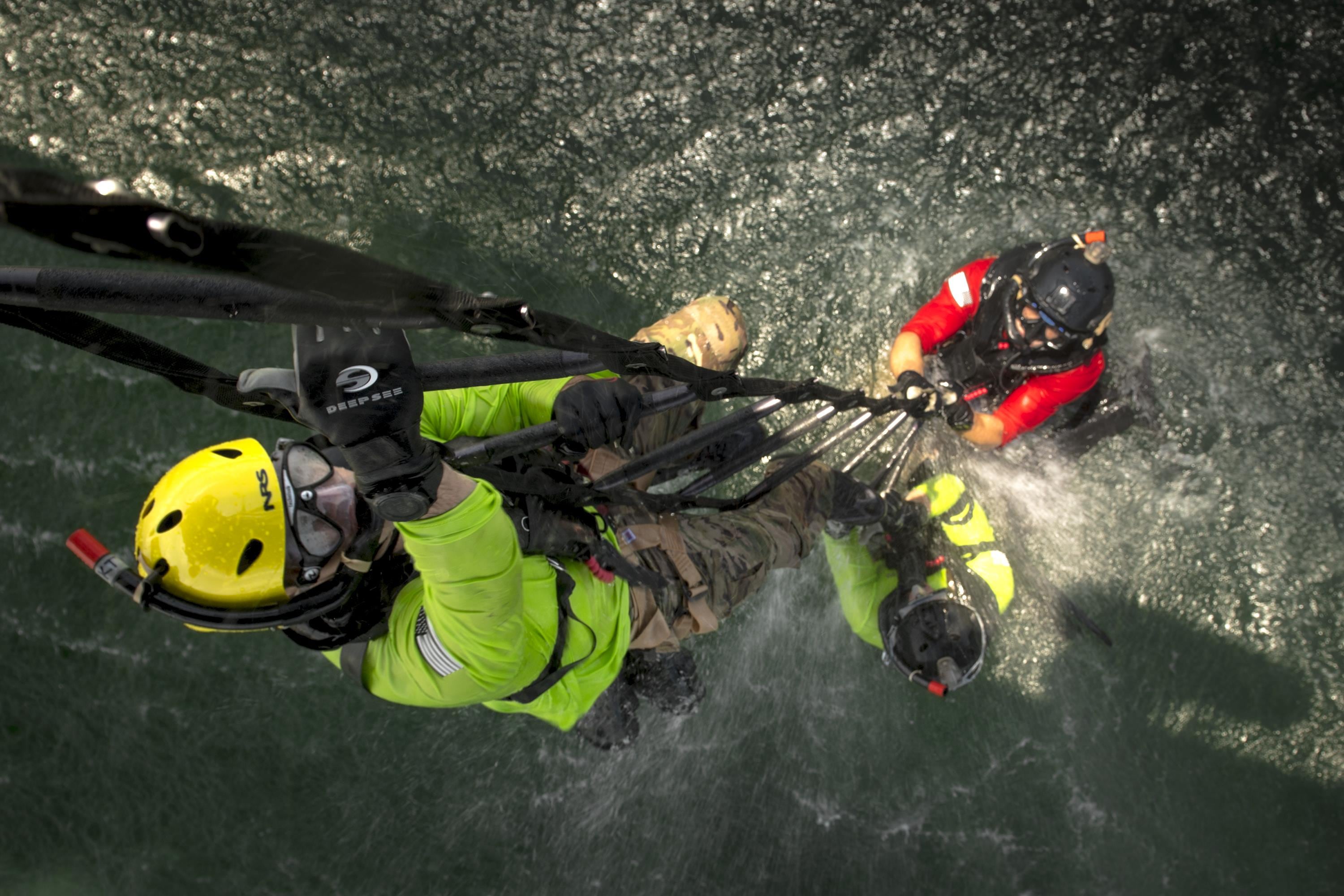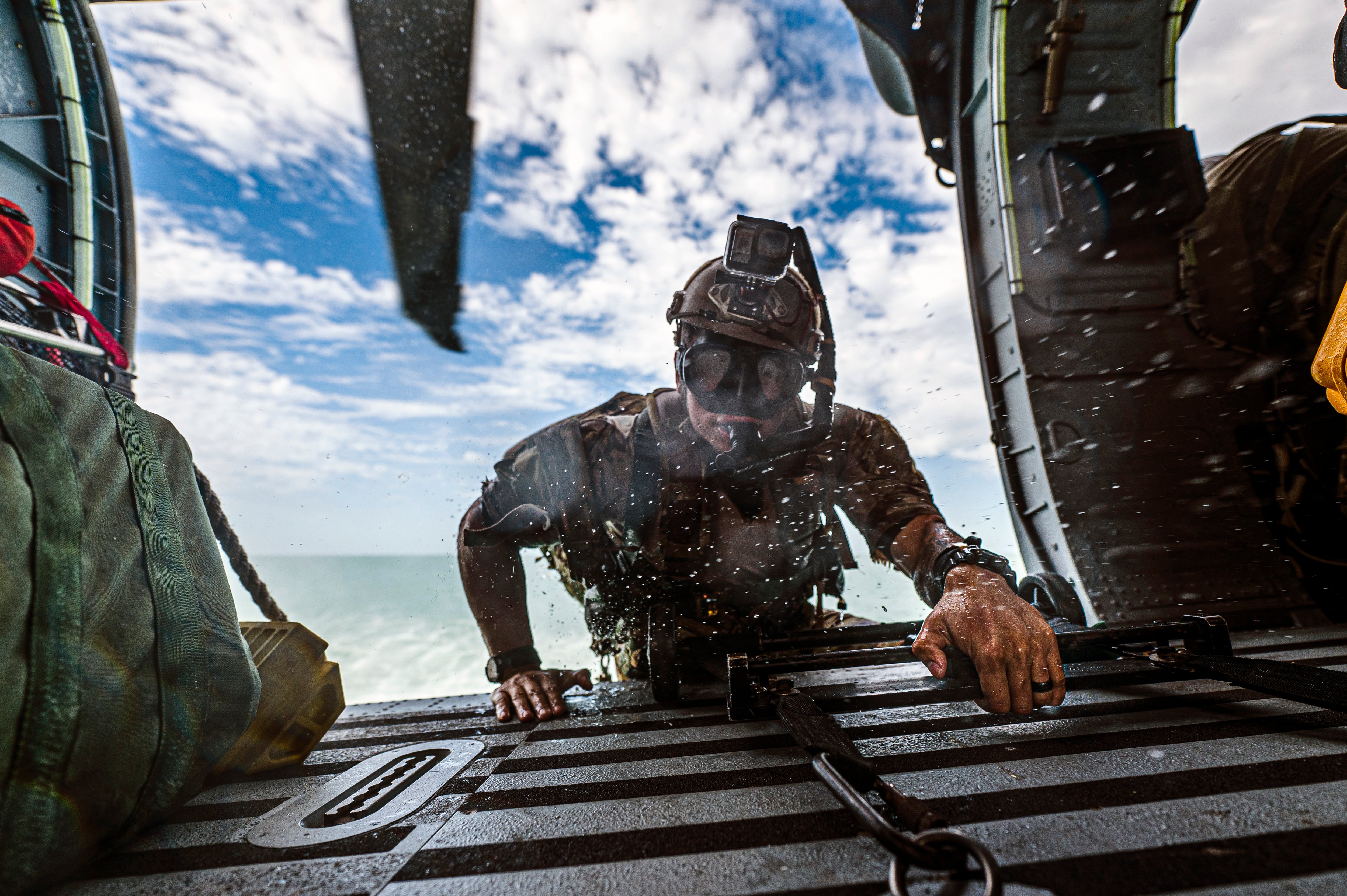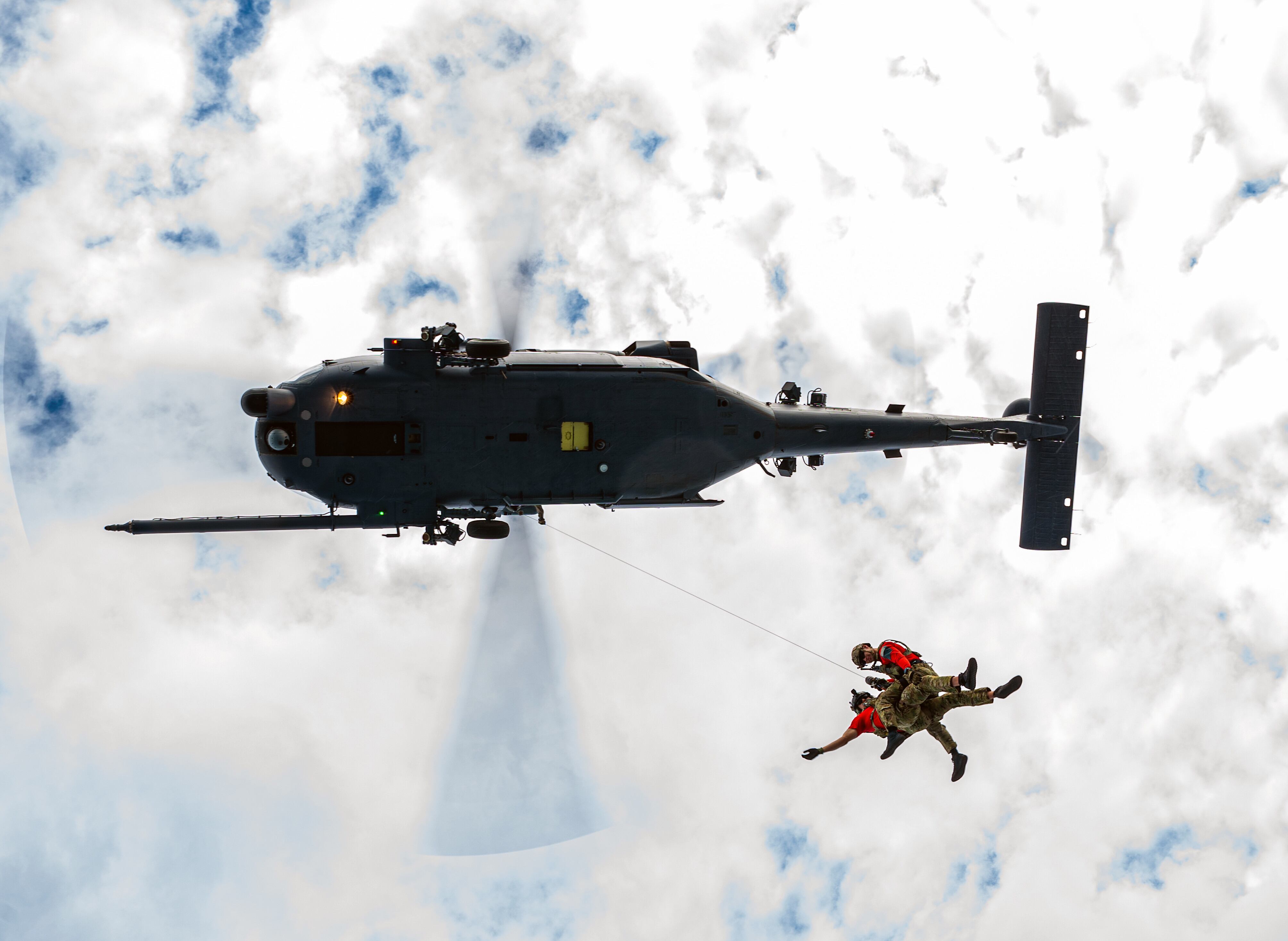WASHINGTON — In the opening days of a future war against China, an F-35 pilot on a mission is tracked and shot down by air defenses. He safely ejects — but is trapped deep inside enemy territory.
Standing between him and his comrades: A bristling array of surface-to-air missiles, radars, enemy fighters and other defenses. If the U.S. Air Force sends a traditional combat search and rescue helicopter into that highly contested airspace, the chances are high it gets shot down, leaving the service with several more pilots and pararescuemen in need of their own rescuing.
Instead, the Air Force tries something new. It sends an autonomous drone — a self-piloting air taxi — whose smaller electric propellers let it operate much more quietly than a helicopter with massive rotors. If the drone is spotted and shot down, the Air Force hasn’t lost another airman and can try again with another drone to save the pilot. His rescue is still far from certain. But at least he’s got a chance.
This is one way search and rescue operations could play out in the years to come, as the Air Force tries to figure out how it will fight its next major war. As the service shifts from the last 20 years of fighting in the Middle East toward a potential conflict against China or Russia and their modern militaries, it needs to change how it rescues downed pilots and other personnel to account for the far more complex threat environments they’d face.
Combat search and rescue airmen in the next war will likely have to navigate a contested airspace with enemy surface-to-air missiles, radar and hostile aircraft. The missions could come days — perhaps even weeks — after the crash, as the rescuers wait for an opportunity to go in. And there could be much more rescuing of downed pilots from the open sea.
The first major sign of how combat rescue is changing: The Air Force said when it released its fiscal 2023 budget that it wants to trim one-third of its planned purchase of HH-60W Jolly Green II combat rescue helicopters, the successor to the HH-60G Pave Hawk.
And more changes are coming. Already, officials from Air Combat Command, the Pentagon, the Air Force Research Laboratory, Air Force Materiel Command and AFWERX are trying to write the playbook for future rescues.
That includes figuring out: How do combat search and rescue personnel get to an airman on the wrong side of the front line? What happens when the enemy has advanced air defenses that can target a traditional helicopter miles away? And if they can’t reach the airman immediately, how do they help that individual survive in the meantime?

Top Air Force leaders, including Secretary Frank Kendall, are adamant that by purchasing fewer Jolly Green II helicopters, the service is not backing away from its traditional combat search and rescue, or CSAR, role — but that it must change how it executes that mission.
“There are some places where you’re just not going to take a helicopter,” Kendall said in an April interview, referring to highly contested environments. “It’s just not going to work with that reality.”
With the Air Force bringing this question to the fore, Congress also wants to know more about the service’s plans. The House version of the FY23 National Defense Authorization Act would require a report from the Air Force on its future vision for CSAR — one that will work in the age of great power competition.
In this report, the Air Force must spell out its CSAR requirements for specific geographic areas most likely to require rescue missions; assess the rotary-, tilt- and fixed-wing aircraft needed for the mission; and describe CSAR capabilities the service will need.
Congress also wants to know about existing capability gaps, particularly those that might stem from buying fewer HH-60Ws.
But it will likely be at least a decade before the Air Force can field the capabilities that would allow a new approach to combat rescue, and some of the capabilities may not yet exist.
A ‘wickedly hard’ job
During the wars in the Middle East and Afghanistan, the Taliban and other local militant forces were often spread out and therefore more likely to be near where U.S. or allied troops went down. The Air Force had to act faster than the enemy — ideally rescuing troops within one to four hours.
The shocking case of Lt. Moaz al-Kasasbeh, the Jordanian pilot who in 2015 was captured and then burned to death in a cage by the Islamic State group, was a constant reminder to the combat rescue community of the criticality of rapid recovery.
But the Air Force also had advantages over local militants. CSAR airmen were also nearby, usually launching from bases in Iraq and Afghanistan. Groups like the Taliban and ISIS lacked aircraft or significant surface-to-air defenses to threaten CSAR airmen, until they got within range of weapons such as rocket-propelled grenades.
The threat posed by a likely future enemy will be much more advanced.
Col. Timothy Matlock, Air Combat Command’s personnel recovery division chief, told Defense News that combat rescue in the future will likely be backing up pilots flying fifth-generation aircraft, such as the F-35, “that take them farther, faster and into enemy-controlled areas where vertical lift platforms can’t go.”
While there are some ideas for how to make helicopters go faster, Matlock wrote in his emailed statement, it will be a while before they’re in widespread use.
The Air Force’s solution for a CSAR strategy that would work against China or Russia will likely be a two-pronged effort: focusing on helping downed personnel survive on their own for a longer period of time — potentially at sea and dealing with injuries — and adopting new methods of rescue that could involve autonomous drones.

Christopher Mouton, a scholar with the think tank Rand, said the Air Force is on the right track.
“The [search and rescue] problem is wickedly hard,” Mouton, who specializes in personnel recovery and special operations, said in an interview. “It’s no longer just: ‘Oh, we’ll just buy X and it’s solved.’ You need to be tackling this from all directions.”
Finding the solutions won’t be easy for many reasons, he said — not least of which because any enemy capable of shooting down an advanced fighter, such as an F-35, would be an even more significant threat to a search and rescue effort.
One potential way to solve that problem: Remove search and rescue pilots and airmen from the equation entirely by using drones. Air Force Chief of Staff Gen. CQ Brown said in April the service is weighing how autonomous systems could help rescue endangered troops or resupply them.
The Air Force’s experimental Agility Prime electric vertical-takeoff-and-landing vehicle — essentially an air taxi — is one autonomous, pilotless CSAR option under consideration, said Lt. Col. Patrick Lowe, a combat rescue officer and chief of Air Combat Command’s personnel recovery requirements division. Autonomous ships under development by the Defense Innovation Unit could also play a role, he said.
Apart from the safer pilotless feature, Agility Prime’s electric nature and smaller propellers make it quieter than a traditional fuel-powered helicopter like the Jolly Green II. It’s also smaller and more lightweight than conventional helicopters. These factors could give it a better shot at slipping in and out of enemy territory undetected.
Lt. Col. John Tekell, who runs the Agility Prime program for AFWERX, the Air Force’s technology innovation hub within AFRL, told Defense News that this type of aircraft could also help rescue someone trapped on a chemically or biologically contaminated battlefield, where the Air Force might not want to send more people.
However, Tekell said, Agility Prime’s range and speed wouldn’t match that of a traditional helicopter, and a drone may not be strong enough to survive in a combat environment. The HH-60G Pave Hawk, for example, has a maximum speed of 184 mph, but LIFT Aircraft’s Hexa, one of the aircraft undergoing testing as part of Agility Prime, could reach just half of that with a max speed of 90 mph.
Funding is also an open question. Such a program would likely require a major investment in artificial intelligence. If Agility Prime turns out to be the Air Force’s solution, in order to make it a reusable vehicle that is cheap enough so that losing one would be acceptable — the Air Force would need to buy a lot.
Tekell said multiple vendors will likely supply different types of Agility Prime aircraft, each with varying capabilities. The price for each could range from the low hundreds of thousands of dollars to about $5 million.
Air Force officials have floated the idea of having a more traditional helicopter, akin to the Pave Hawk or Jolly Green II, that flies autonomously. The Defense Advanced Research Projects Agency’s ALIAS, or Aircrew Labor In-Cockpit Automation System, program flew a UH-60 Black Hawk entirely unmanned for the first time earlier this year, showing such a concept is feasible. But losing one of those helicopters, even with no one aboard, would be extremely costly.
There remains debate in the Air Force over the possible scenarios that could complicate using an autonomous aircraft for combat rescue, and whether it’s possible to solve them. For instance, what if the downed pilot has a broken leg or other injury and is unable to climb into a drone helicopter? Or what if a downed pilot is trapped where a helicopter can’t land?
In that latter scenario, a pararescueman would usually help the pilot to a spot where they can board the helicopter. But if that pararescueman is traveling on the drone aircraft sent to save the pilot, the aircraft is no longer attritable.
In the meantime, the Air Force is trying to apply some newer capabilities to assist with combat rescue. For example, Matlock said, the service is considering how fifth-generation fighters as well as space and cyber capabilities can distract or counter enemy capabilities long enough for a rescue team to dash in and out. The service also wants to break down stovepipes that isolate intelligence and data so that CSAR teams can pull together more information to help them plan the mission.
Behind enemy lines — for much longer
The Air Force also knows it must rethink how it supplies aviators so they can survive longer on their own.
One way to do that is with the upcoming replacement to the Combat Survivor Evader Locator, or CSEL, hand-held radio, which dates back to the 1990s. Downed personnel use the radio to communicate with their rescuers — exchanging crucial information on their location, their condition and the status of the rescue effort, as well as advice on how to treat injuries, survive off the land and avoid detection.
The Air Force is starting the research and development phase for the CSEL’s successor, dubbed the Next Generation Survival Radio, with plans to release a request for proposals in August and for the new radio to hit the field within the next six years. Air Combat Command would not provide funding amounts for the effort.
The service hopes the new radio will be less bulky, with smaller and longer-lasting batteries, and more user-friendly; the old version requires users to push multiple buttons to communicate.
The replacement must be able to survive the extreme G-forces of an ejection — up to 15 Gs — and it needs to be waterproof to a certain depth and temperature. It will also have to use secure networks.
The new version must also work with the Mobile User Objective System, or MUOS, a narrowband satellite communications system designed to be more secure and reliable than its predecessors, and able to operate in a range less susceptible to weather or other interference.
“We’ve got a multiyear acquisition strategy. However, it’s all about aligning those stars,” Lowe said. “Will that capability we want be ready to fit within that form factor so we can get there? I think the jury’s still out. But we will continue to energize the defense industry to be able to provide that solution.”
Lowe also said Air Combat Command is in the process of fielding to combat search and rescue airmen advanced tactical radios that use MUOS. Better communications security is vital in a rescue, where the enemy is hunting for the same person. If adversaries can hack into the downed pilot’s communications, they can determine the individual’s location.
“We’ve got to provide a solution that doesn’t ride on the back of legacy waveforms that are vulnerable to our adversaries,” Lowe said.
In addition, the seat kits that downed personnel use to survive after ejecting — which typically include a signal mirror, medical supplies, food and water (or tools to obtain them), a weapon, and camouflage face paint — are also undergoing review.
Those kits were largely standardized in the past, but the Air Force has realized one size does not fit all; what a downed pilot would need in Europe differs from what one would need in Africa or the Indo-Pacific region. In response, the Air Force is working on more modular kits that combatant commanders can customize and tailor to each theater.
Lowe said the Air Force is also working with the commercial sector to design desalinization kits small and effective enough to fit into a seat kit so a downed aviator can survive for a long period on a raft — a possible scenario in a war against China in the Indo-Pacific region, where landing on water is more likely.
A more robust life raft, better insulation to protect against the elements and enough food are other upgrades in the works for the seat kit tailored to survive at sea.
Following the murder of the Jordanian pilot at the hands of ISIS, the Air Force began including a GAU-5A gun in some seat kits. The weapon is essentially a smaller version of the M4 rifle that allows for rapid assembly and disassembly. The GAU-5A is intended to give downed aviators more firepower than a pistol.
“The same aircraft … flying in AFRICOM, CENTCOM, EUCOM and INDOPACOM all have different requirements,” Lowe said, referring to U.S. military commands with various areas of responsibility. “If you’re in CENTCOM and AFRICOM, your personal protection may take a priority, so it’s going to take up space. While in INDOPACOM, the priority would probably be food and water procurement. So we want to give [commanders] options.”
If downed aviators can survive on their own longer, Lowe said, that would give rescuers more time to map out the best rescue plan.
And in a fierce battle where multiple aircraft are downed in rapid succession, Air Force combat rescuers will need to make hard choices about who to save first. This could involve prioritizing the injured or those most in danger, while circling back to rescue those who are healthy and have intact kits.
The Air Force is also trying to beef up SERE training — or survival, evasion, resistance and escape — for aviators who are at higher risk of being downed. That includes pushing more SERE specialists into wings to hold refresher courses for aviators closer to deployment.
As for Agility Prime, it could be years before the aircraft is ready for combat rescue, Tekell said, noting other less life-or-death missions are a better place to build up this autonomous capability.
“There’s some stepping stones we need to go through as far as which missions make the most sense to do first,” Tekell said. “Missions like test and training range support [or] cargo resupply and delivery make a little bit more sense to explore and develop the infrastructure and training and technology [that is needed] prior to doing some more advanced concepts like combat search and rescue.”
And, he added, people will need to see that the autonomous aircraft is reliable before they trust it with their lives, or the life of an airman under their command.
“The average person is not going to just climb into an aircraft that’s autonomous and let it take them somewhere,” Tekell said. “They’re only going to get in it if there’s a pilot, another person there, flying them from point A to point B.”
Stephen Losey is the air warfare reporter for Defense News. He previously covered leadership and personnel issues at Air Force Times, and the Pentagon, special operations and air warfare at Military.com. He has traveled to the Middle East to cover U.S. Air Force operations.





